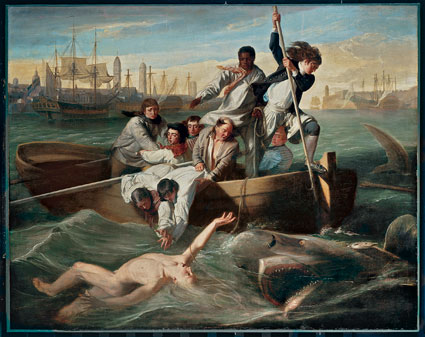John Singleton Copley’s famous painting Watson and the Shark was commissioned by Brook Watson to document a harrowing event at age 14 as a maritime sailor. While swimming alone off Havana Cuba in 1749, Watson was repeatedly attacked by a shark. The shark first removed some flesh from Watson’s right calf, then bit off his entire left foot at the ankle. Rescued by his shipmates, the teenager subsequently had to have his left leg amputated below the knee. In the painting Copley has depicted Watson as a romanticized ghostly, nude figure on his back, woefully vulnerable to the more powerful beast acting on animal instinct. One seldom sees a more graphic vision of the classic theme Man versus Nature.

John Singleton Copley, "Watson and the Shark," 1778, National Gallery of Art, Washington, Ferdinand Belin Fund
In Los Angeles we have made an art form of controlling our environment: manicured palm trees, diverted river water, flood channels, fire breaks. However, once in a while Angelenos are starkly reminded of natural threats in our midst—say, by this Los Angeles Times photo last October of a shark breaching in Santa Monica Bay near Gladstone’s restaurant.
As a regular ocean swimmer in this area, such photos are of immense interest to me. In chatting with the photographer, Randy Wright, I found he has recorded several more shark sightings there. On the Shark Research Committee website, local surfers have posted dozens of similar accounts, including some nibbles by smaller sharks. I hide from my swim buddies the fact that a sea lion pup with head cleanly sheared off was discovered in our Redondo Beach training area.
Of course, such photos and reports generate countless theories within the swim/surf community of what provokes a shark attack, or doesn’t. For instance, “they will attack if attracted by sparkly jewelry, or by wetsuits resembling seals." "They won’t savagely attack humans because we’re not blubbery enough." "They’ll only strike in deep water because they spring up from below.” Almost 250 years since Copley’s painting, shark tales continue to ignite the imagination. It seems there are only three facts everyone can agree on: 1) Sharks are an important part of the ecosystem unfairly maligned and overhunted. 2) Swimmers must respect the ocean for what it is—the wild—and acknowledge one’s limitations, even a few yards off Gladstone's. And 3) One’s chances of being attacked or being fatally wounded are extremely rare, aggravated by swimming alone—Watson's mistake.
Renee Montgomery, Assistant Director of Collections Information



